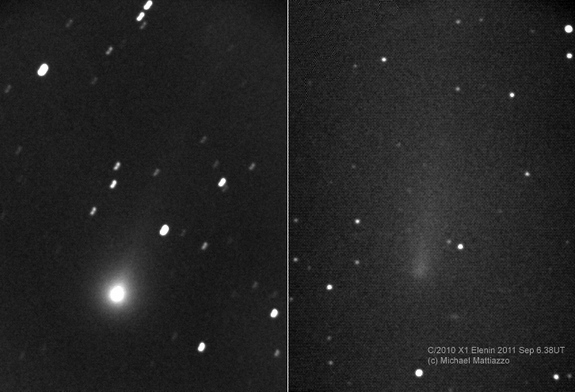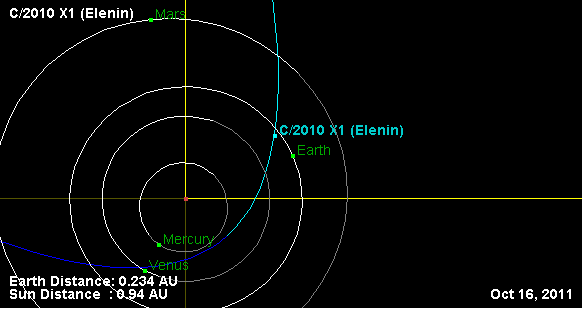Comet Elenin’s debris to pass by Earth on Sunday

The moment long feared by conspiracy theorists is nearly upon us: The "doomsday comet" Elenin will make its closest approach to Earth Sunday (Oct. 16). Or what's left of it will, anyway.
Comet Elenin started breaking up in August after being blasted by a huge solar storm, and a close pass by the sun on Sept. 10 apparently finished it off, astronomers say. So what will cruise within 22 million miles (35.4 million kilometers) of our planet Sunday is likely to be a stream of debris rather than a completely intact comet. Astronomers are having trouble finding it, so it's probably dead and gone. That means it probably won't present much of a skywatching show Sunday, scientists have said.
And the leftovers of Elenin won't return for 12,000 years, astronomers say.

Elenin's apparent demise may come as a relief to some folks since apocalyptic rumors circulating on the Internet portrayed the comet as a major threat to Earth.
One theory claimed Elenin would set off havoc on Earth after aligning with other heavenly bodies, spurring massive earthquakes and tsunamis. Another held that Elenin was not a comet at all, but in fact, a rogue planet called Nibiru that would bring about the end times on Earth. After all, the comet's name could be taken as a spooky acronym: "Extinction-Level Event: Nibiru Is Nigh." Rumors were that it would cause three days of darkness when it's trail comes between Earth and Sun, but that was to happen on September 26th and we don't remember the darkness. You decide for yourself.
"Elenin was a second-rate, wimpy little comet that never should have been noted for anything, really," said astronomer Don Yeomans of the Near-Earth Object Program Office at NASA's Jet Propulsion Laboratory in Pasadena, Calif. "It was not even a bright one."
Elenin's remains will not be the only objects about to make their closest pass of Earth. One day after the Elenin flyby, the small asteroid 2009 TM8 will zip close by. Like Elenin, it poses no risk of striking our home planet.
Asteroid 2009 TM8 is about 21 feet (6.4 meters) wide and the size of a schoolbus. It will come within 212,000 miles of Earth – just inside the orbit of the moon – when it zips by on Monday morning (Oct. 17).

JPL Small-Body Database Browser
Elenin was named after its discoverer, Russian amateur astronomer Leonid Elenin, who spotted it in December 2010. Before the icy wanderer broke up, its nucleus was likely 2 to 3 miles (3 to 5 km) in diameter, scientists say. Elenin never posed any threat to life on Earth. It was far too small to exert any appreciable influence on our planet unless it managed to hit us.
Elenin's supposed connection to earthquakes was just a correlation and a weak one at that. Relatively strong earthquakes occur every day somewhere on Earth, so it's easy — but not statistically valid — to blame some of them on the comet's changing position. We were writing about that correlation in the article The Elenin Timeline and earthquake connection!.
Elenin's crumbs will soon leave Earth in the rear-view mirror, speeding out on a long journey to the outer solar system. (Space.com)
C/2010 X1 (Elenin): A morning comet
This comet has apparently disintegrated. It faded dramatically after a solar flare on Aug 20. Images at the end of August revealed a spreading, more diffuse coma. It is highly unlikely that this comet survived perihelion in mid-September. This comet begins the month in Virgo. Even without the disintegration, it would fade rapidly, moving into Auriga by month's end. The best visibility is late in the month as seen from the southern hemisphere.
| Latitude | Visibility October 1 | Visibility October 8 | Visibility October 15 | Visibility October 22 | Visibility October 29 | Nights Visible |
| 55o N | Low in the eastern sky during morning twilight at ~05:40 | Fairly high in the eastern sky during morning twilight at ~04:50 | Very low in the eastern sky in moonlight at ~00:10 | Very low in the eastern sky at ~21:10 | High during morning twilight at ~06:40 | 1- |
| 40o N | Low in the eastern sky during morning twilight at ~05:40 | Low in the eastern sky at ~03:30 | Very low in the eastern sky in moonlight at ~01:00 | Very low in the eastern sky at ~22:20 | High during morning twilight at ~06:10 | 1- |
| Equator | Very low in the eastern sky during morning twilight at ~05:30 | Very low in the eastern sky at ~03:50 | Very low in the eastern sky in moonlight at ~02:10 | Very low in the eastern sky at ~00:00 | High during morning twilight at ~05:30 | 1- |
| 30o S | High during morning twilight at ~10:50 | Very low in the eastern sky during morning twilight at ~04:30 | Very low in the eastern sky in moonlight at ~03:20 | Very low in the eastern sky at ~01:20 | Fairly high in the northern sky during morning twilight at ~04:50 | 1- |

Commenting rules and guidelines
We value the thoughts and opinions of our readers and welcome healthy discussions on our website. In order to maintain a respectful and positive community, we ask that all commenters follow these rules:
We reserve the right to remove any comments that violate these rules. By commenting on our website, you agree to abide by these guidelines. Thank you for helping to create a positive and welcoming environment for all.